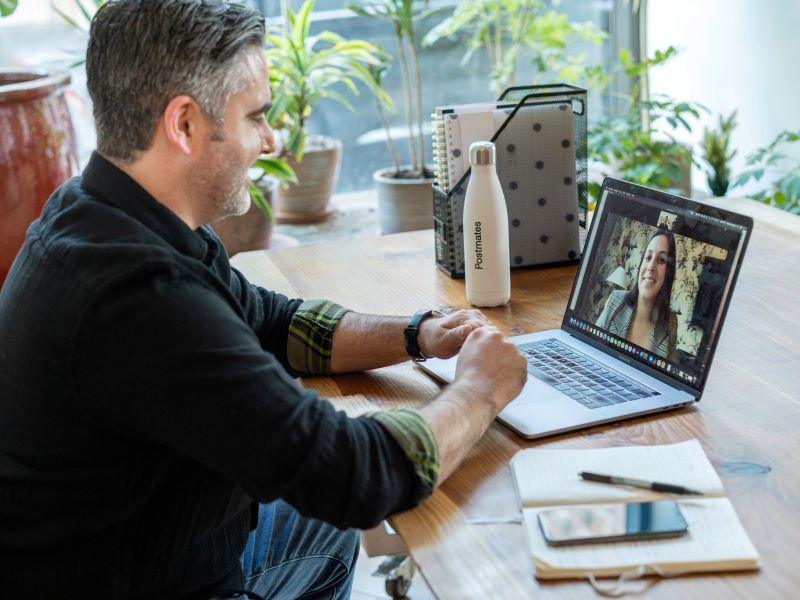
Designing online courses for better learning and well-being outcomes

At the beginning of the pandemic, universities’ focus was necessarily on managing the shift to remote delivery of teaching and assessment. However, for those of us on the front line, it quickly became apparent that looking after our students’ well-being was equally important – if not more so.
All of us involved in teaching online have had to find a balance between live classes and pre-recorded material. In doing so, the emphasis has generally been on ensuring the best possible learning outcomes for our students.
It’s become clear that students greatly value the inclusion of live component – whether that’s a live lecture or a discussion of the taught material. And it’s about not just their learning and engagement but their well-being, also.
Timetable interaction
Timetabled human interaction is important. We know that even before the pandemic, an increasing proportion of our students were reporting mental health concerns. The pandemic has only exacerbated these problems. Being able to watch a pre-recorded video in bed, while avoiding human contact, cannot be healthy – even if it’s convenient in the short term.
So, maintaining opportunities for live interaction with lecturers and peers is critical for sustaining students’ well-being as well as their learning and development.
Looking beyond how we have delivered our teaching on the graduate apprenticeship programme, we have enjoyed success with a range of other measures intended to support our students remotely. Indeed, many of these measures will remain in place post-pandemic.
Outside the classroom
First, it’s been important to create opportunities for socialising and community building. If someone hasn’t been to university before, they may not realise the importance of building their social and professional network, often through chance encounters on campus.
Extracurricular activities hosted online can help foster a sense of community and encourage such encounters – we’ve had success with online quizzes and movie-watch parties, for example. It can also be worth signposting the university clubs and societies that continue to run, albeit in virtual form.
Inside the classroom
We can make small adjustments to our teaching, too, such as opening the Zoom room for a period before the start of scheduled classes. This allows students to chat, in much the same way as they might if they were waiting outside a lecture theatre.
We have stressed the importance of peer support while studying remotely. Practical ways we have encouraged mutual support include creating small online peer-support groups and highlighting aspects of our coursework that students can and should ask their group to help with.
A more light-hearted initiative has been the introduction of a “most helpful student” award. Voted on by the students themselves, this informal prize underscores the importance we place on peer support, while recognising the efforts of those students who go above and beyond in helping their peers.
A light touch
I’d advocate for taking a more light-hearted approach to our interactions with students across the board. Adding an element of fun to online classes can help lift students’ and lecturers’ mood and keep everyone that little bit more engaged.
This might involve dropping in a few pop-culture references during lectures, or adding a couple of humorous options to multiple-choice quizzes. Better still, tailoring references to our students’ interests shows we care about them and helps create a sense of community that can be missing when studying remotely. It sounds silly, but it works.
Private spaces
A more tangible success on our programme was the creation of a private online chat channel for students facing mental health challenges. This channel was conceived as a space in which students could chat freely with peers who might also value having someone to talk to.
About one fifth of our students joined the channel, and while conditions such as anxiety and depression are not often addressed directly, there is a tacit understanding that anyone on the chat might be dealing with such concerns.
Varied communication
Students might just need to talk to you if they feel isolated. That might mean experimenting with different modes of contact, such as text chat, audio calls or drop-in sessions, to find something that works for a particular student. You might need to be more proactive in encouraging students to talk to you than you are initially comfortable with!
We have a duty of care to our students, and we should remember that even if we are focused solely on academic outcomes, no student will achieve their full potential if their mental health is neglected.
Institutional support
The responsibility is not all on us as teachers, though – it’s worth becoming familiar with the support your institution can offer to students, too. We’re not generally trained in dealing with serious mental health issues, so it’s entirely appropriate that we direct students elsewhere, if needed.
But we may never know if a student is struggling if we don’t reach out in the first place, and this is especially true when we’re teaching remotely.
Care begins at home
Finally, this is all taking its toll on us, as staff. We need to look after ourselves, too, if we’re to be able to support our students. While this may seem harder to do, if we burn out, our ability to help our students will diminish.
We must look after our own well-being and that of our students to ensure their academic success. And that’s going to take a little more work while we’re teaching and studying remotely.
Matthew Barr is programme director for the graduate apprenticeship in software engineering at the University of Glasgow.
This advice is based on the research paper, “Online delivery of intensive software engineering education during the Covid-19 pandemic”, co-authored by Matthew Barr, Syed Waqar Nabir and Derek Somerville, all at the University of Glasgow.


